Multi-Parameter Sensing Device to Detect Liquid Layers Using Long-Period Fiber Gratings
Abstract
:1. Introduction
2. Operational Principles and Device Design
2.1. Principles of Operation
2.2. Sensor Device Design
3. Experiment Setup
4. Multi-Parameter Sensing Experimental Results and Discussions
4.1. Liquid Level Measurements for One Liquid Only (Experiment #1 to #3)
4.2. Layered Liquid Interface and Level Detection (Experiment #4 to #5)
5. Device Sensitivity Study
5.1. Influence from Rod Materials (Experiment #4 and #6)
5.2. Influence from Rod Diameters (Experiment #4 and #7)
5.3. Influence from LPFG Cladding Modes (Experiment #4, #8 and #9)
6. Conclusions and Future Work
- (a)
- Operational principles of the sensor device show that a constant slope will be present for level changes and a sudden change in the slope of the level measurements is expected for the occurrence of boundaries in layered insoluble liquids.
- (b)
- The laboratory experiments clearly validated that the developed sensor device could detec the interface and level changes of layered liquid using the example of water, decane, and propylene glycol.
- (c)
- Experimental study also showed that the materials of the holding rods of the LPFG sensor on the sensor device had very little influence on the sensor’s sensitivity; however, the diameter of the holding rod did influence the accuracy of the device which will require a calibration before the sensor’s practical application.
- (d)
- The selection of cladding modes of the LPFG will also affect significantly the sensitivity of the sensor device. A cladding mode of LP08 was tested to be two times more sensitive when compared to LP07, and more than ten times more sensitive than LP06.
Author Contributions
Funding
Conflicts of Interest
References
- Beutel, T.; Ferreira, N.; Leester-Schädel, M.; Büttgenbach, S. Robust pressure sensor for measurements in boundary layers of liquid fluids with medium total pressures. In Proceedings of the International Society for Optical Engineering, Prague, Czech Republic, 5 May 2011. [Google Scholar]
- Infineon Technologies AG. Liquid Level Sensing Measuring Liquid Levels Using Hall Effect Sensors. Application Note, Rev. 1.0. 2009. Available online: https://www.infineon.com/dgdl/AppNote_Liquid_Level_Sensing_Rev.1.0.pdf?fileId=db3a30432313ff5e0123a385f3b2262d (accessed on 12 February 2009).
- Makanjuola, N.T.; Shoewu, O.O.; Akinyemi, L.A.; Ajasa, A.A. Design and development of microcontroller based liquid level detector with graphical output. Pac. J. Sci. Technol. 2015, 16, 173–181. [Google Scholar]
- Kumar, B.; Rajita, G.; Mandal, N. A review on capacitive-type sensor for measurement of height of liquid level. Meas. Control 2014, 47, 219–226. [Google Scholar] [CrossRef]
- Meribout, M.; Habli, M.; Al-Naamany, A.; Al-Busaidi, K. A new ultrasonic-based device for accurate measurement of oil, emulsion, and water levels in oil tanks. In Proceedings of the 21st IEEE Instrumentation and Measurement Technology Conference, Como, Italy, 18–20 May 2004; pp. 1942–1947. [Google Scholar]
- Wang, A.; Gunther, M.F.; Murphy, K.A.; Claus, R.O. Fiber-optic liquid-level sensor. Sens. Actuators A 1992, 35, 161–164. [Google Scholar] [CrossRef]
- Guo, T.; Zhao, Q.; Duo, Q.; Zhang, H.; Xue, L.; Huang, G.; Dong, X. Temperature-insensitive fiber bragg grating liquid-level sensor based on bending cantilever beam. IEEE Photonics Technol. Lett. 2005, 17, 2400–2402. [Google Scholar]
- Wang, D.; Cao, M.; Li, C.; Li, D.; Chen, Y.; Xu, X.; Xu, J.; Li, Y.; Wan, Z.; Wang, B. Fiber bragg grating liquid level sensor with double pressure and temperature sensitivities. Procedia Eng. 2011, 15, 704–709. [Google Scholar] [CrossRef]
- Bhatia, V. Optical fiber long period grating sensors. Opt. Lett. 1996, 21, 692–694. [Google Scholar] [CrossRef] [PubMed]
- Ye, X.W.; Su, Y.H.; Han, J.P. Structural health monitoring of civil infrastructure using optical fiber sensing technology: A comprehensive review. Sci. World J. 2014, 652329. [Google Scholar] [CrossRef] [PubMed]
- Zheng, S.; Zhu, Y.; Krishnaswamy, S. Fiber humidity sensors with high sensitivity and selectivity based on interior nanofilm-coated photonic crystal fiber long-period gratings. Sens. Actuators B 2013, 176, 264–274. [Google Scholar] [CrossRef]
- Tian, F.; He, Z.; Du, H. Numerical and experimental investigation of long-period gratings in photonic crystal fiber for refractive index sensing of gas media. Opt. Lett. 2012, 37, 380–382. [Google Scholar] [CrossRef] [PubMed]
- Khaliq, S.; James, S.W.; Tatam, R.P. Fiber-optic liquid-level sensor using a long-period grating. Opt. Lett. 2001, 2, 1224–1226. [Google Scholar] [CrossRef]
- Grice, S.; Zhang, W.; Sugden, K.; Bennion, I. Liquid level sensor utilizing a long period fiber grating. In Proceedings of the International Society for Optical Engineering, San Diego, CA, USA, 3–4 August 2009. [Google Scholar]
- Fu, H.; Shu, X.; Zhang, A.; Liu, W.; Lin, Z.; He, S.; Bennion, I. Implementation and characterization of liquid-level sensor based on a long-period fiber grating Mach–Zehnder interferometer. IEEE Sens. J. 2011, 11, 2878–2882. [Google Scholar] [CrossRef]
- Xue, H.; Xu, Z.; Chen, H.; Yang, Y.; You, J.; Yan, J.; Fu, H.; Zhang, D. Continuous liquid level sensor based on a reflective long period fiber grating interferometer. Meas. Sci. Technol. 2015, 26, 037001. [Google Scholar] [CrossRef]
- Wang, J.; Luo, C. Long-period fiber grating sensors for the measurement of liquid level and fluid-flow velocity. Sensors 2012, 12, 4578–4593. [Google Scholar] [CrossRef] [PubMed]
- Huang, Y.; Chen, B.; Chen, G.; Xiao, H.; Khan, S.U. Simultaneous detection of liquid level and refractive index with a long-period fiber grating based sensor device. Meas. Sci. Technol. 2013, 24, 095303. [Google Scholar] [CrossRef] [Green Version]
- Yu, Y.; Hung, H.; Liaw, S.; Shih, M.; Kishikawa, H.; Goto, N. Simultaneously two-parameter measurement using tilted fiber grating and long period fiber grating. Microw. Opt. Technol. Lett. 2017, 59, 1122–1125. [Google Scholar] [CrossRef]
- Jiang, M.; Zhao, Z.; Li, K.; Yang, F. Long-period fiber grating cascaded to thin-core fiber for simultaneous measurement of liquid refractive-index and temperature. Sens. Rev. 2018, 38, 79–83. [Google Scholar] [CrossRef]
- First-Sensor.com. Measuring Transition Points in Liquids with Different Densities with CLC and CLW Capacitive Level Sensors. Application Note, E-11160. Available online: https://www.yumpu.com/en/document/view/43889645/measuring-transition-points-in-liquids-with-different-sensortechnics (accessed on 11 November 2015).
- Huang, Y.; Xiao, H. Detecting layered liquids using long period fiber grating sensors. In Proceedings of the 2nd International Electronic Conference on Sensors and Applications, Basel, Switzerland, 15–30 November 2015; pp. 1–8. [Google Scholar]
- Li, Y.J.; Wei, T.; Montoya, J.A.; Saini, S.V.; Lan, X.W.; Tang, X.L.; Dong, J.H.; Xiao, H. Measurement of CO2 laser irradiation induced refractive index modulation in single mode fiber toward long-period fiber grating design and fabrication. Appl. Opt. 2008, 47, 5296–5304. [Google Scholar] [CrossRef] [PubMed]
- Shu, X.W.; Zhang, L.; Bennion, I. Sensitivity characteristics of long period fiber gratings. J. Lightw. Technol. 2002, 20, 255–266. [Google Scholar]
- Yaws, C.L. Chemical Properties Handbook; McGraw-Hill: New York, NY, USA, 1999; pp. 159–179. [Google Scholar]
- O’Neil, M.J. The Merck Index: An Encyclopedia of Chemicals, Drugs, and Biologicals; Merck Research Laboratories: San Francisco, CA, USA, 2006. [Google Scholar]
- Ivanov, O.V.; Nikitov, S.A.; Gulyaev, Y.V. Cladding modes of optical fibers: Properties and applications. Physics 2006, 49, 167–191. [Google Scholar]
- Patrick, H.J.; Kersey, A.D.; Bucholtz, F. Analysis of the response of long period fiber gratings to external index of refraction. J. Lightwave Technol. 1998, 16, 1606. [Google Scholar] [CrossRef]

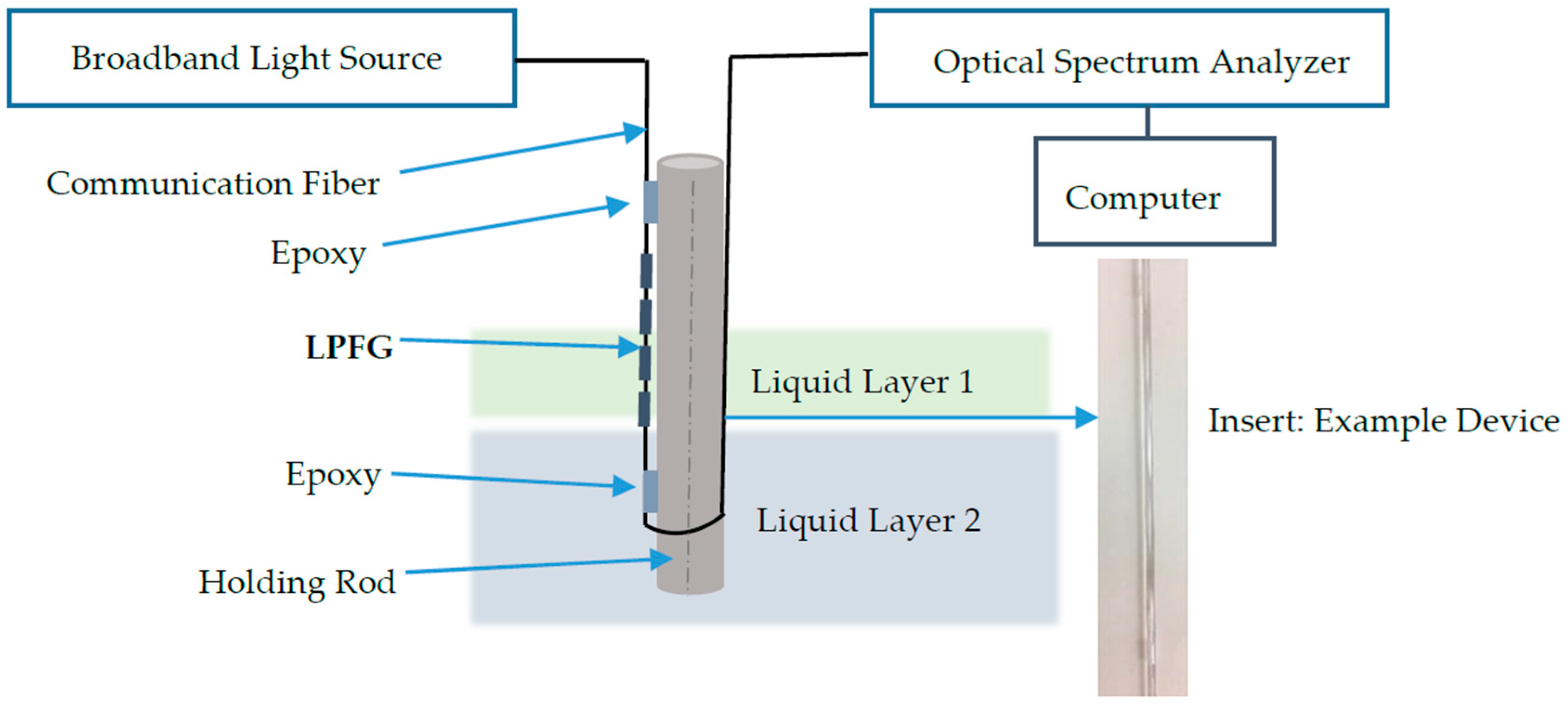

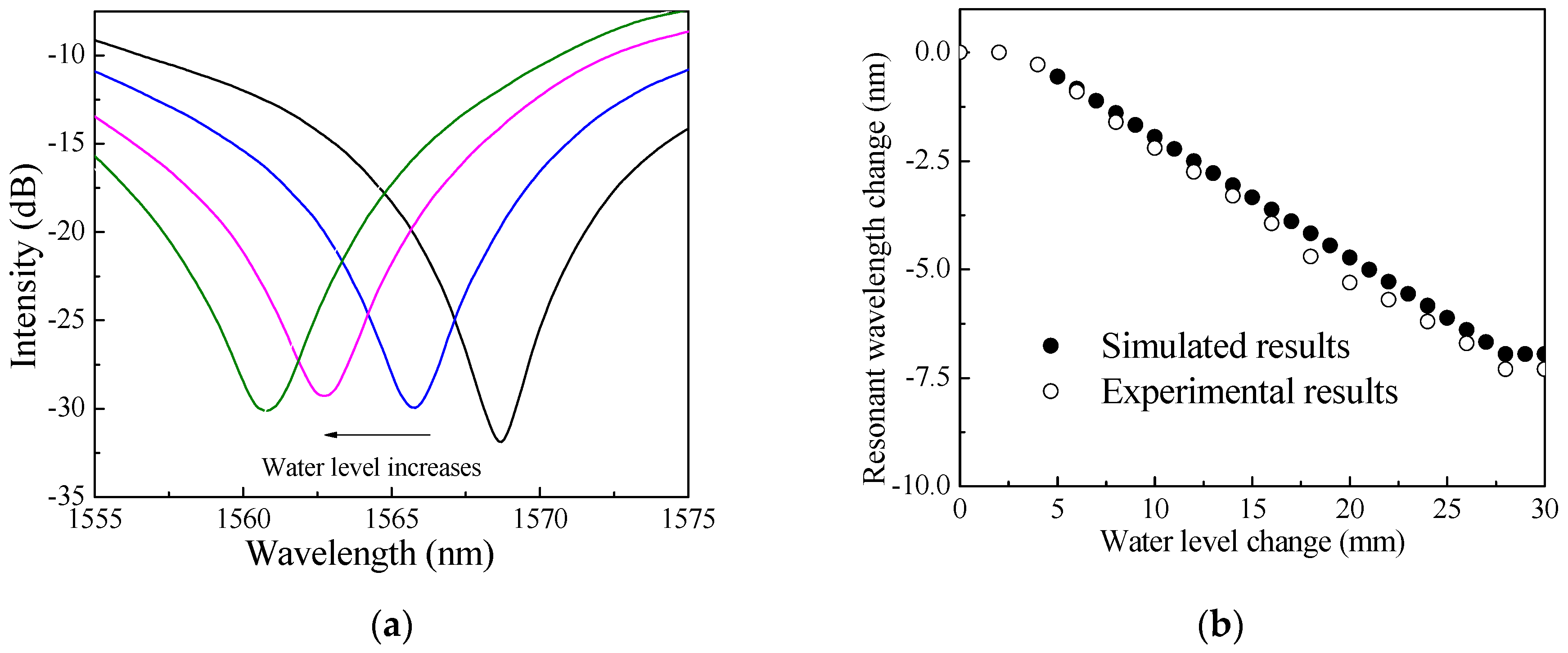
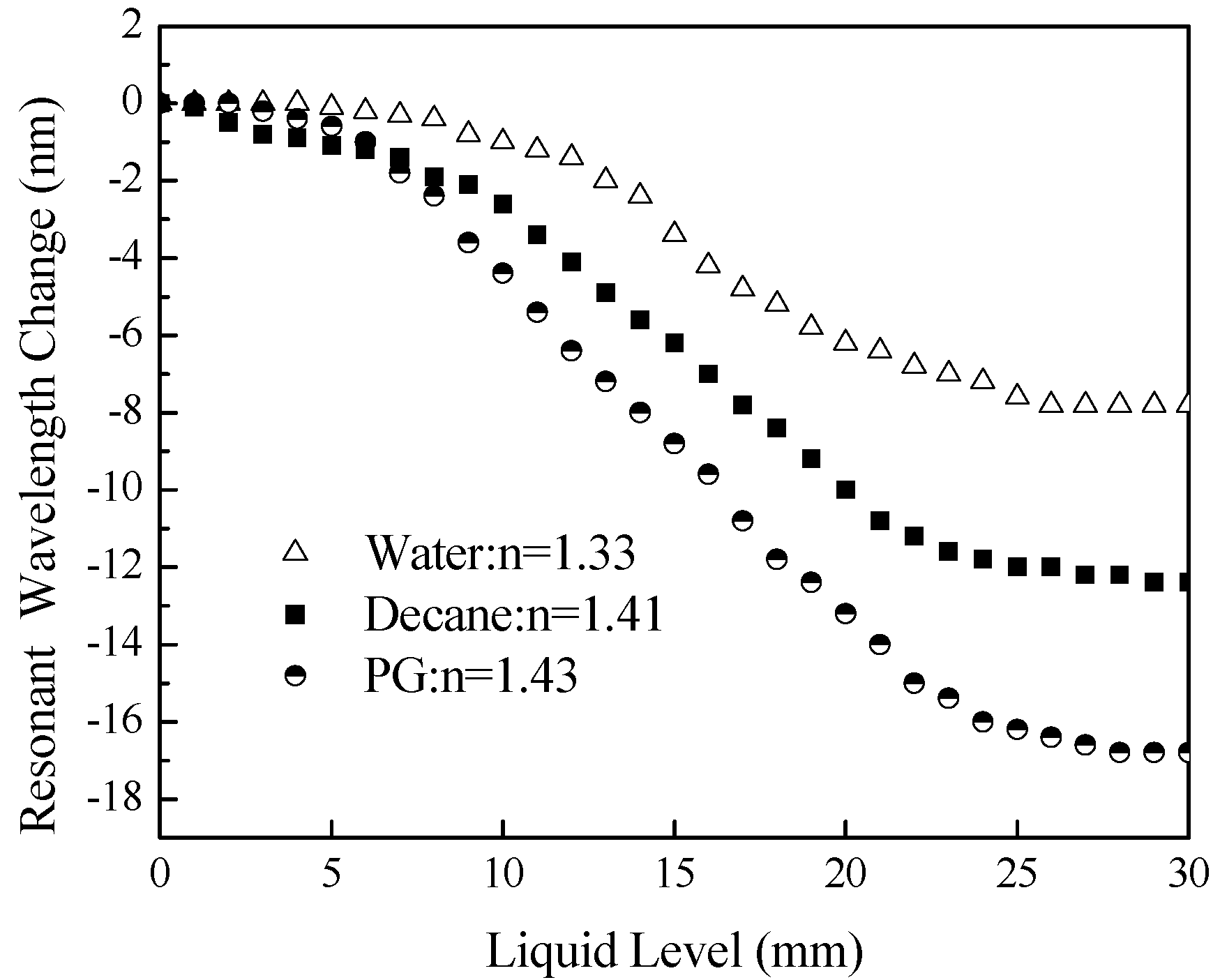




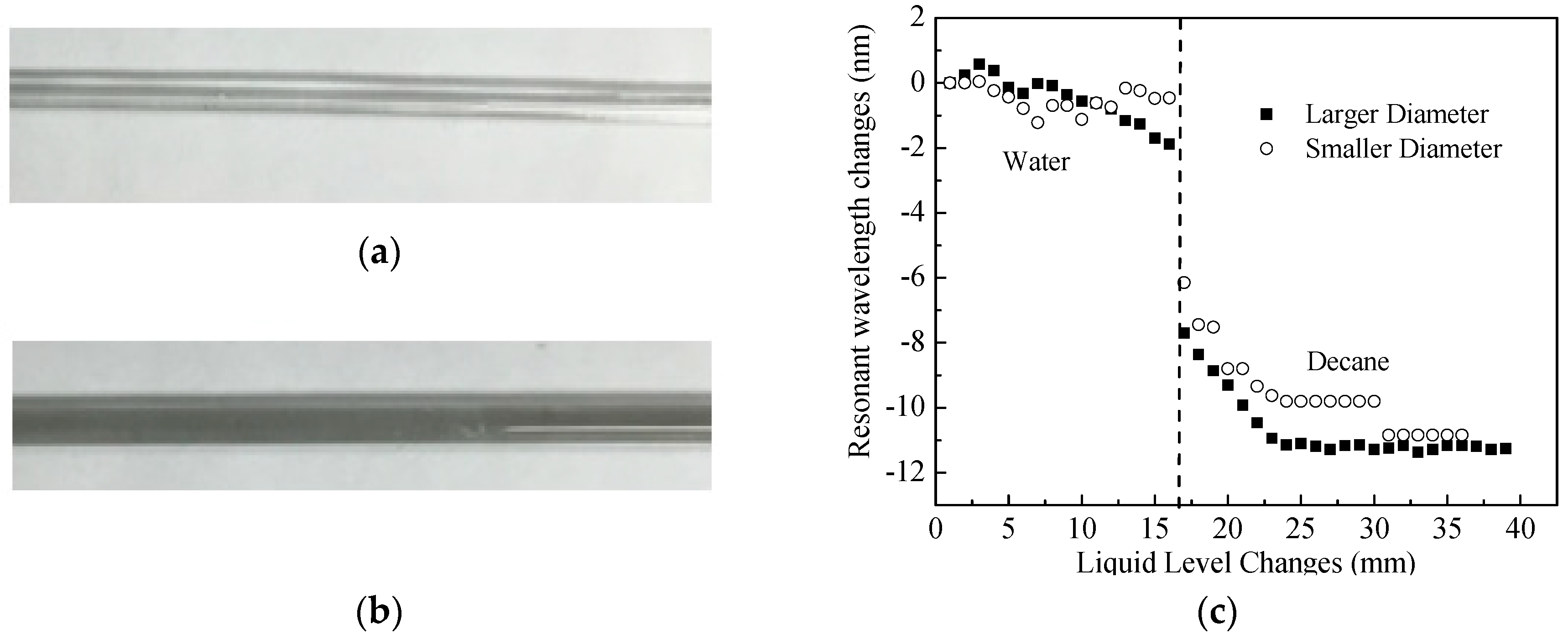
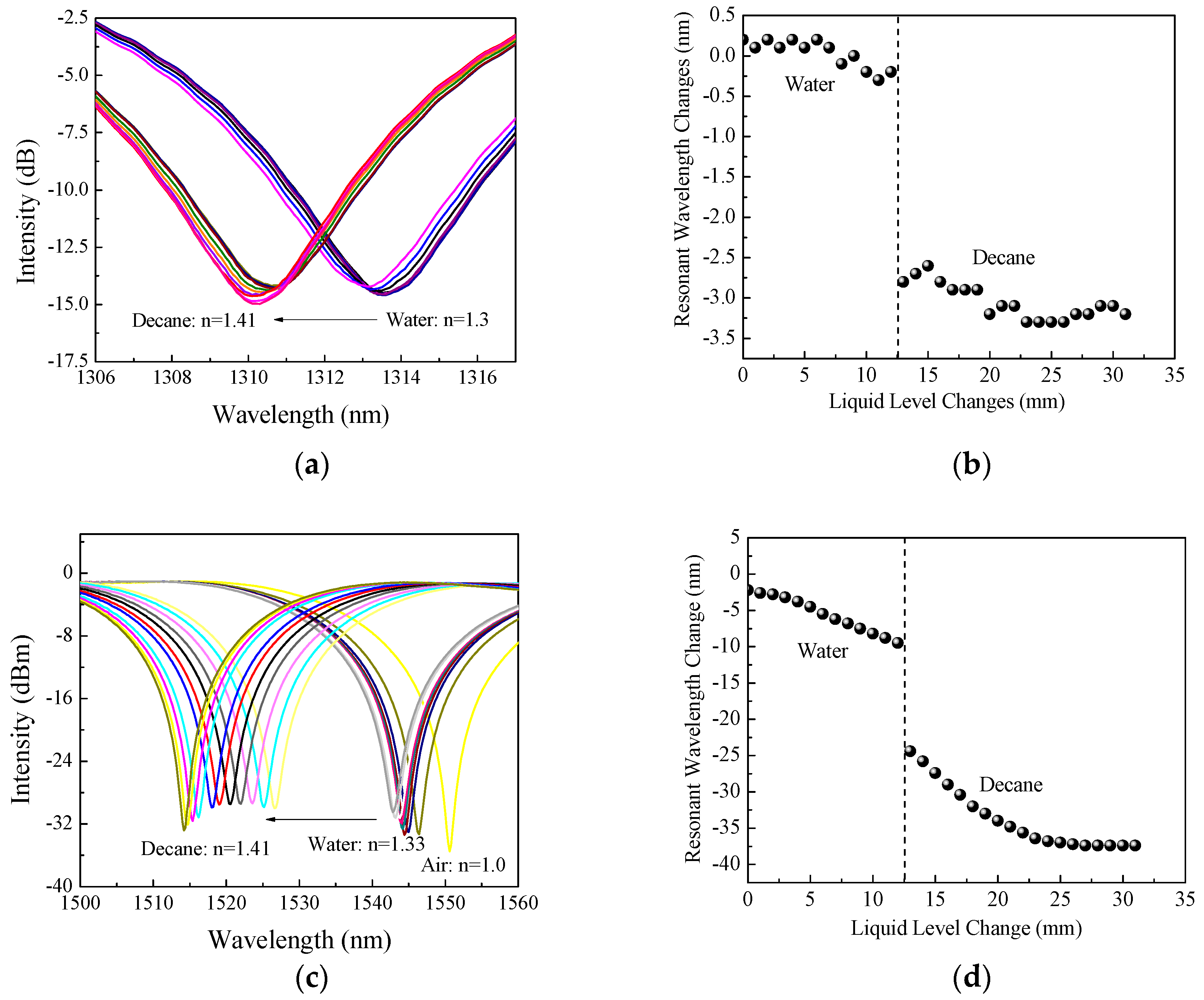
| Experiment No. | Liquids Used | Rod Material, Rod Size, and LPFG Cladding Modes |
|---|---|---|
| #1 | Water Only | Glass rod with 3 mm outer diameter, LP07 |
| # 2 | Decane Only | Glass rod with 3 mm outer diameter, LP07 |
| # 3 | Propylene Glycol Only | Glass rod with 3 mm outer diameter, LP07 |
| # 4 | Water + Decane | Glass rod with 3 mm outer diameter, LP07 |
| # 5 | Propylene glycol + Decane | Glass rod with 3 mm outer diameter, LP07 |
| # 6 | Water + Decane | Metal rod with 3 mm outer diameter, LP07 |
| # 7 | Water + Decane | Glass rod with 2 mm outer diameter, LP07 |
| # 8 | Water + Decane | Glass rod with 3 mm outer diameter, LP06 |
| # 9 | Water + Decane | Glass rod with 3 mm outer diameter, LP08 |
© 2018 by the authors. Licensee MDPI, Basel, Switzerland. This article is an open access article distributed under the terms and conditions of the Creative Commons Attribution (CC BY) license (http://creativecommons.org/licenses/by/4.0/).
Share and Cite
Pan, Z.; Huang, Y.; Xiao, H. Multi-Parameter Sensing Device to Detect Liquid Layers Using Long-Period Fiber Gratings. Sensors 2018, 18, 3094. https://doi.org/10.3390/s18093094
Pan Z, Huang Y, Xiao H. Multi-Parameter Sensing Device to Detect Liquid Layers Using Long-Period Fiber Gratings. Sensors. 2018; 18(9):3094. https://doi.org/10.3390/s18093094
Chicago/Turabian StylePan, Zhihui, Ying Huang, and Hai Xiao. 2018. "Multi-Parameter Sensing Device to Detect Liquid Layers Using Long-Period Fiber Gratings" Sensors 18, no. 9: 3094. https://doi.org/10.3390/s18093094
APA StylePan, Z., Huang, Y., & Xiao, H. (2018). Multi-Parameter Sensing Device to Detect Liquid Layers Using Long-Period Fiber Gratings. Sensors, 18(9), 3094. https://doi.org/10.3390/s18093094






